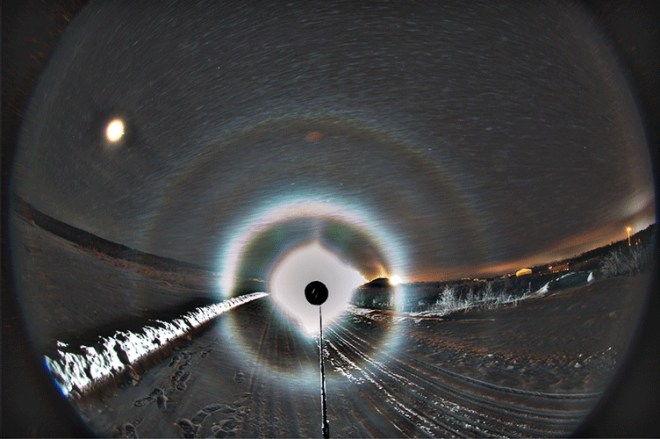Halos from pyramidal crystals, including plate and column arcs, were observed by Andreas Möller on June 09th, 2018, in the East-German town of Schwedt at the Oder river.
He first noted the right part of the 18° halo, or its respective lateral plate arc, at about 09:00 CEST when taking a look from a roof window. The halo then vanished after several minutes. While walking to a better suited observing site, Andreas observed the 23° plate arc becoming brighter, but once arrived, its intensity decreased again. On his way back, he then noted the 9° halo getting stronger. Home again, he started a time lapse series. The peak activity of the display was then recorded at 10:25, including the 18° halo (or plate arc), 23° plate arc and 9° circular halo:
 After 10:45, only an ordinary 22° halo remained. The full video from 10:05 to 11:45 is available here. Furthermore, a stack calculated from several of the time lapse images shows, after unsharp masking, parts of the 35° halo, and also a brightening at the right side of the 20° halo:
After 10:45, only an ordinary 22° halo remained. The full video from 10:05 to 11:45 is available here. Furthermore, a stack calculated from several of the time lapse images shows, after unsharp masking, parts of the 35° halo, and also a brightening at the right side of the 20° halo:
 This feature fits to the contact position of the 20° column arc at this sun elevation (48°). Column arcs from pyramidal crystals are considered rare. Some excellent photographs from China have been published here recently. Interestingly, the sun elevation was also higher than 40° in these cases.
This feature fits to the contact position of the 20° column arc at this sun elevation (48°). Column arcs from pyramidal crystals are considered rare. Some excellent photographs from China have been published here recently. Interestingly, the sun elevation was also higher than 40° in these cases.
 Simulating this display requires some care. The crystal distribution was certainly not homogeneous, indicated by the missing left column arc. Thus the odd radius halos on the left side of the display are generated by a different crystal population than those on the right. The best one can do is try some kind of “compromise simulation” that shows a little more than the observation by filling some gaps on the left side. Remarkably, most of the halos can be simulated well using a combination of only a plate and a column set of crystals.
Simulating this display requires some care. The crystal distribution was certainly not homogeneous, indicated by the missing left column arc. Thus the odd radius halos on the left side of the display are generated by a different crystal population than those on the right. The best one can do is try some kind of “compromise simulation” that shows a little more than the observation by filling some gaps on the left side. Remarkably, most of the halos can be simulated well using a combination of only a plate and a column set of crystals.
The plate component is fairly standard, with a high Gaussian tilt up to 40° ensuring that most of the rings’ circumferences become visible, while maintaining the high intensity of the 23° plate arc. The shape of the column component was designed in order to suppress arcs which are not present in the observation. I dare not to vouch for aerodynamic plausibility here, and just add the speculation that these might possibly be the optical active parts of larger aggregates.
The intensity distribution of the 35° halo is not matched well, but to fix this a third crystal component must be introduced.

















































